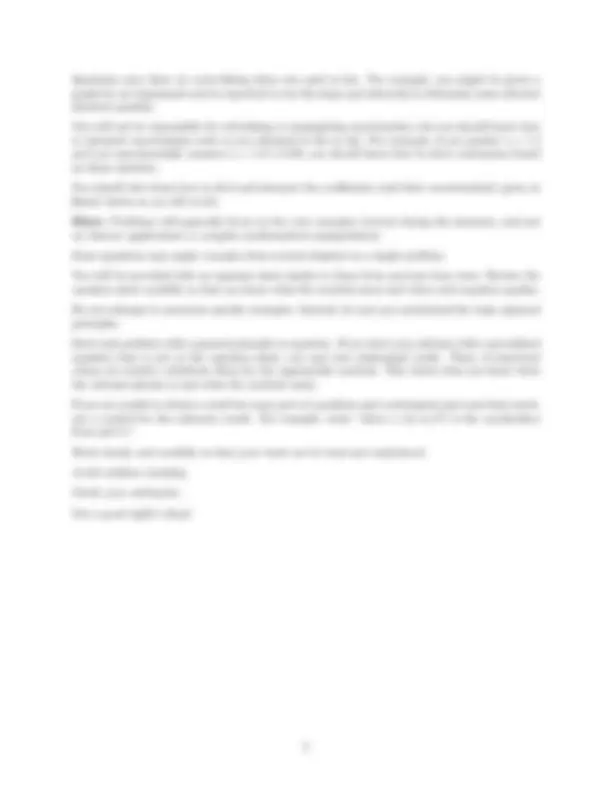



Study with the several resources on Docsity

Earn points by helping other students or get them with a premium plan


Prepare for your exams
Study with the several resources on Docsity

Earn points to download
Earn points by helping other students or get them with a premium plan
Community
Ask the community for help and clear up your study doubts
Discover the best universities in your country according to Docsity users
Free resources
Download our free guides on studying techniques, anxiety management strategies, and thesis advice from Docsity tutors
Material Type: Exam; Professor: Dougherty; Class: Electricity & Magnetism; Subject: Physics; University: Lafayette College; Term: Spring 2009;
Typology: Exams
1 / 2

This page cannot be seen from the preview
Don't miss anything!


Physics 132 Spring 2009 Final Exam Notes Final: Tuesday, May 12, 2009, 9–11 a.m. Hugel 100
Office Hours and Help Times: I expect to be available Monday, May 11, 9–11 a.m. and 2– p.m.
Topics: The final exam will be cumulative. It will contain a mix of problems of varying degrees of difficulty. Some problems might include qualitative as well as quantitative questions. Some problems may focus on a single topic or chapter, while others may include topics from several different chapters. Consult the syllabus for the specific list of topics. The following general areas may be covered:
Ch. 21–23 Electrostatic forces and fields. Ch. 24–25 Electric potential and capacitance. Ch. 26–27 Electrical conduction and DC circuits. Ch. 28–29 Magnetic forces and fields. Ch. 30 Electromagnetic induction. Ch. 27, 30, & 31 RC, LR, and LC circuits. Ch. 16 Waves. Ch. 32–33 Maxwell’s equations and electromagnetic waves. Ch. 35–36 Interference and Diffraction.
Omissions: The following topics listed on the original syllabus will not be on the final:
Derivation of Wave Speed 16. Phasors 16. Standing Waves (Mathematical Derivation) 16. E^ ~ Due to a Charged Disk 22. Electric Potential Energy of a System of Point charges 24. Dielectrics 25.6–25. Microscopic View of Ohm’s Law 26. Semiconductors 26. Superconductors 26. Ammeter and Voltmeter 27. Hall Effect 28. Inductors and Inductance 30. Mutual Induction 30. Damped RLC Oscillations 31. Intensity in Double-Slit Interference 35. Michelson’s Interferometer 35. Intensity in Single-Slit Diffraction, Quantitatively 36. Circular Aperture 36. Dispersion and Resolving Power 36. Diffraction by Organized Layers 36.
Lab-Inspired Questions:
Questions may draw on curve-fitting ideas you used in lab. For example, you might be given a graph for an experiment and be expected to use the slope and intercept to determine some relevant physical quantity.
You will not be responsible for calculating or propagating uncertainties, but you should know how to interpret uncertainties such as you obtained in fits in lab. For example, if you predict a = 1. 5 and you experimentally measure a = 1. 47 ± 0 .05, you should know how to draw conclusions based on those numbers.
You should also know how to find and interpret the coefficients (and their uncertainties!) given in Excel charts as you did in lab.
Hints: Problems will generally focus on the core concepts covered during the semester, and not on obscure applications or complex mathematical manipulations.
Some questions may apply concepts from several chapters to a single problem.
You will be provided with an equation sheet similar to those from previous hour tests. Review the equation sheet carefully so that you know what the symbols mean and when each equation applies.
Do not attempt to memorize specific examples. Instead, be sure you understand the basic physical principles.
Start each problem with a general principle or equation. If you start your solution with a specialized equation that is not on the equation sheet, you may lose substantial credit. Then, if numerical values are needed, substitute them for the appropriate symbols. This shows that you know what the relevant physics is and what the symbols mean.
If you are unable to obtain a result for some part of a problem and a subsequent part uses that result, use a symbol for the unknown result. For example, write “where a (in m/s^2 ) is the acceleration from part b.”
Work clearly and carefully so that your work can be read and understood.
Avoid reckless rounding.
Check your arithmetic.
Get a good night’s sleep!